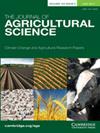综合非光化学猝灭(NPQ)测量方法鉴定气候变化时代耐涝大豆基因型
IF 2.2
4区 农林科学
Q2 AGRICULTURE, MULTIDISCIPLINARY
引用次数: 0
摘要
气候变化对全球农业产生了负面影响,包括大豆生产。研究表明,气温上升和干旱、洪水等极端天气事件显著降低了大豆产量。开发耐涝大豆基因型对确保粮食安全至关重要。传统的育种计划受到费力和不精确的视觉评定方法的限制。利用成像技术进行植物表型分析的高通量平台提供了潜在的解决方案,但它们缺乏潜在生理机制的信息。非光化学猝灭(Non-photochemical quenching, NPQ)是光合作用中的一种分子适应,它可以耗散多余的光能,保护植物免受伤害。本研究旨在将NPQ测量整合到高通量表型分析程序中,以鉴定耐涝大豆基因型。该研究评估了160种大豆基因型的耐涝性,确定了具有更高粮食产量潜力的基因型。随后,选择10个基因型监测淹水条件下NPQ的响应。结果表明,籽粒产量高的基因型也表现出较好的NPQ性能,表明抗洪能力与能量耗散能力呈正相关。其中,58I60 RSF IPRO、64HO130 I2X和BRS 525在籽粒产量、植株叶面积和水涝条件下的光防护能力方面表现出较强的育种潜力,具有进一步开发利用的潜力。这些发现表明,将NPQ测量结果整合到高通量表型平台中,有助于为育种计划确定耐涝大豆基因型,从而在面对气候变化时产生更有弹性的作物。有必要进行进一步的实地研究,以验证这些假设并改进未来气候情景的作物模型。本文章由计算机程序翻译,如有差异,请以英文原文为准。
Integrating Non-photochemical Quenching (NPQ) Measurements for Identifying Flood-Tolerant Soybean Genotypes in the Era of Climate Change
Climate change has negatively affected agriculture worldwide, including soybean production. Studies have shown that rising temperatures and extreme weather events like droughts and floods significantly reduce soybean yields. Developing flood-tolerant soybean genotypes is crucial for ensuring food security. Conventional breeding programs are limited by laborious and imprecise visual rating methods for flooding tolerance identification. High-throughput platforms for plant phenotyping using imaging techniques offer potential solutions, but they lack information on underlying physiological mechanisms. Non-photochemical quenching (NPQ) is a molecular adaptation in photosynthesis that dissipates excess light energy, protecting plants from damage. This study aimed to integrate NPQ measurements into high-throughput phenotyping procedures to identify flooding-tolerant soybean genotypes. The study evaluated 160 soybean genotypes for flooding tolerance, identifying those with higher grain yield potential. Subsequently, ten genotypes were selected for monitoring NPQ responses under flooded conditions. Results showed that genotypes with higher grain yields also exhibited superior NPQ performance, suggesting a positive correlation between flooding tolerance and energy dissipation capacity. Among these genotypes, 58I60 RSF IPRO, 64HO130 I2X and BRS 525 displayed superior potential and could be further exploited in breeding efforts, considering their grain yield capacity, plant leaf area, and photoprotective capacity under flooding conditions. These findings suggest that integrating NPQ measurements into high-throughput phenotyping platforms can aid in identifying flood-tolerant soybean genotypes for breeding programs, leading to more resilient crops in the face of climate change. Further field studies are warranted to validate these hypotheses and improve crop models for future climate scenarios.
求助全文
通过发布文献求助,成功后即可免费获取论文全文。
去求助
来源期刊

Journal of Agricultural Science
农林科学-农业综合
CiteScore
2.80
自引率
5.00%
发文量
68
审稿时长
1.4 months
期刊介绍:
The Journal of Agricultural Science publishes papers concerned with the advance of agriculture and the use of land resources throughout the world. It publishes original scientific work related to strategic and applied studies in all aspects of agricultural science and exploited species, as well as reviews of scientific topics of current agricultural relevance. Specific topics of interest include (but are not confined to): all aspects of crop and animal physiology, modelling of crop and animal systems, the scientific underpinning of agronomy and husbandry, animal welfare and behaviour, soil science, plant and animal product quality, plant and animal nutrition, engineering solutions, decision support systems, land use, environmental impacts of agriculture and forestry, impacts of climate change, rural biodiversity, experimental design and statistical analysis, and the application of new analytical and study methods (including genetic diversity and molecular biology approaches). The journal also publishes book reviews and letters. Occasional themed issues are published which have recently included centenary reviews, wheat papers and modelling animal systems.
 求助内容:
求助内容: 应助结果提醒方式:
应助结果提醒方式:


